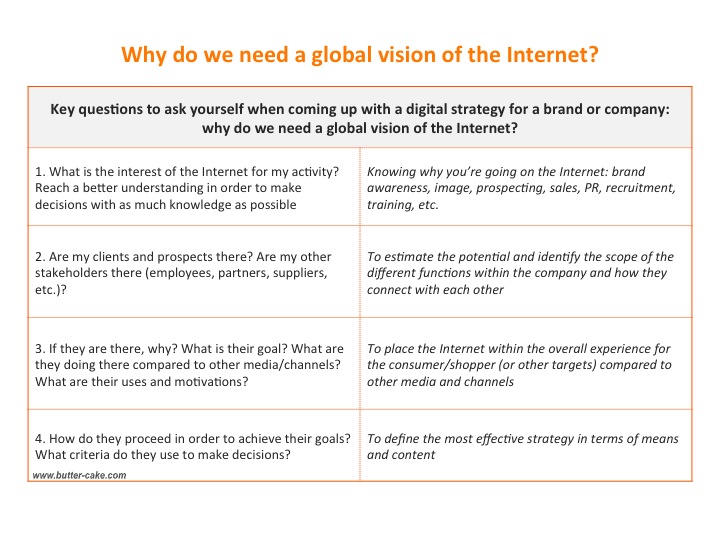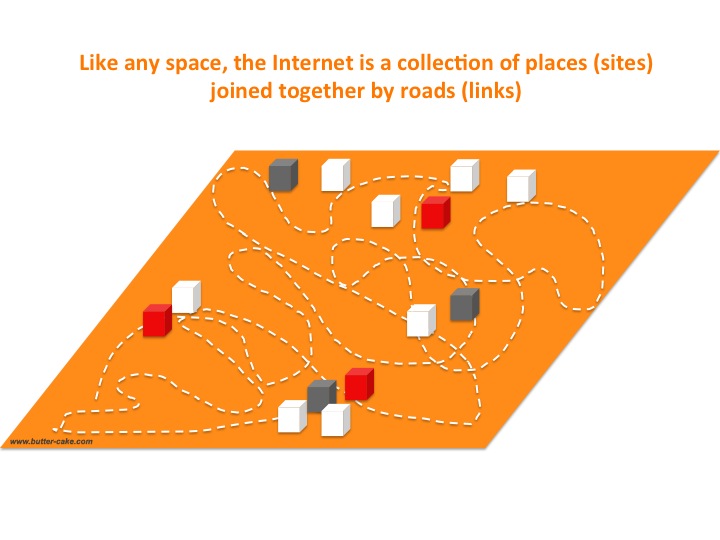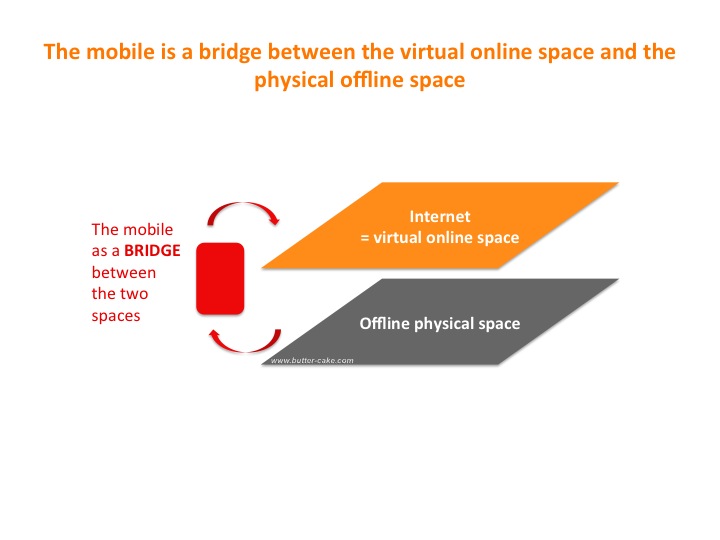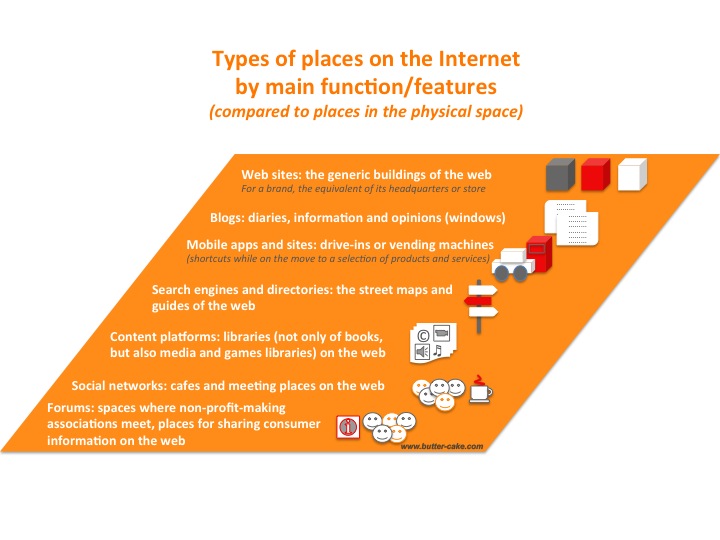Overview: By considering the Internet as a virtual SPACE instead of a media or channel, the different places that make up the web, how they work and the way Internet users use them becomes clearer for companies and brands that have ventured into the web. The same geographical logic can be transposed to define the pillars of a digital strategy: places of presence, traffic, routes, places where audiences gather, accessibility… along with a sense of place and how to behave there.
Today, almost everyone uses the Internet and mobile phones, to name but two major digital “media”. Yet many brands and companies are struggling to come up with a clear and effective digital strategy, as we saw in the previous section; for in order to create a digital strategy, individual and/or operational experience is not enough. Do we start building a house with an engineer or an interior decorator? No, we start by producing an overall architectural project. The same rules apply on the web!
First, we must begin by having a strategic vision of the Internet and other digital media; that is to say, we must examine them from a high-level viewpoint in order to:
– capture what is essential and remove what is peripheral
– connect the different media and channels of action (digital and non-digital) and put them into perspective
– share this vision with all stakeholders so that they can work together on a joint project in a way that does not depend solely on each person’s personal (and thus subjective) experience.
How can we represent the Internet?
Typically, we talk about the Internet as a medium or a distribution channel, and that is how most people see it. Yet this vision of the Internet hides much of its richness and is not helpful when it comes to understanding it as a whole. For a medium or a channel is an intermediary support, which may very well enable communication and interaction between parties (the transmitter and the receiver) who can then act accordingly, but it is not a place of action in and of itself.
However, the Internet is not an intermediary: it is a place of life and action that is also an end in itself for many of its users. Indeed, this also often creates confusion for advertisers: when is the Internet a tool to achieve a goal that may well be located elsewhere, and when is it an end in itself?
Instead, we suggest you think of the Internet as being a SPACE, a three-dimensional living environment that can be compared to the physical world we inhabit. This makes it even easier to understand the different places on the Internet and how the Internet works, for just like any physical space or country, the Internet is made up of a collection of interconnected PLACES (web sites) in which people move around (browse), communicate and act. Sites, blogs, portals, forums, social networks, wikis, mailing lists, platforms … all of these are the shops, houses, shopping malls, libraries, traffic intersections, cafes, parks and public places of the Internet!
Knowing a place and living there does not mean knowing it by heart, all its hidden corners and everyone who participates in life there; it means having an overall vision of the place, understanding how it works, being able to find your way around, knowing its inhabitants and their uses in order to get the most out of what the place has to offer. The rest depends on individual habits and needs: we all create our own maps, our own living area and habits, just as in “real” life.
For a company, the key questions that this vision must be able to answer are:
 Mapping the Internet space: what are the places on the net?
Mapping the Internet space: what are the places on the net?
If the Internet is a space, we need to be able to represent it schematically as we would on a map if we are to understand how the places are organized and be able to find our way around. As when drawing up a map of the physical world, the purpose for which this map will be used will determine which criteria we decide to represent.
 Limitations of the Internet space and the role of the mobile
Limitations of the Internet space and the role of the mobile
In this analysis, we will consider the whole of the connected digital space as being the Internet (or the web, as it is commonly and mistakenly known), which also includes all mobile connections from any device, and mobile applications in the widest sense. Our angle is not strictly technical, but rather one of practical uses that corresponds to how the average consumer thinks of the Internet.
With this spatial approach, the role of the mobile takes on a particularly interesting aspect that can be seen both clearly and obviously: it acts as a BRIDGE between the “online” Internet space and the “offline” physical space (Osama Bédier, VP PayPal). Irrespective of the physical place in which we find ourselves, the mobile phone (especially in its more advanced form, the smartphone) provides us with immediate access to the Internet and lets us browse between the “connected” space and the “real” space, either by accessing the mobile Internet through the phone’s browser, via an application that is itself connected to the Internet, or thanks to some features of the phone such as the possibility to take a photo of a barcode or scan an image, which will then enable us to access the Internet more or less directly or send an email etc, which in turn will enable us to take another action or decision in real life!
We will use the most common classification criteria found on the Internet, that of listing sites according to their function or dominant feature, with the two sometimes overlapping.
– Web site: the “default” web site, when it doesn’t have a particular function, is the equivalent of a generic building in real life, to which we add an adjective to specify its function (residential building, office building, etc) just as we do for sites (news site, brand site, e-commerce site, etc). However, the use of the term “site” implies a certain structure to the content in order to meet a specific goal on the part of the publisher, which tends to be a company more often than a private individual (unlike for blogs). Despite the development of CMS (content management systems) that make them easier to manage, a web site still has a relatively “long-lasting” and “fixed” image, together with a structure that doesn’t change every day and has specific functions and a specific look-and-feel.
Brands have tended to try to get around this restriction by creating many “short-lived” sites that usually correspond to specific communications campaigns with a limited lifespan. This approach reflects the (limited, media-focused) vision that many brands have (or had) of the Internet, since creating short-lived sites for campaigns is a way of transporting the logic of traditional media onto the web. On TV, a campaign benefits from the audience of the “site” on which it is placed. On the Internet, a temporary site does not benefit from any traffic that isn’t specifically directed there, and creating such a site for a specific campaign means also having to map out all the routes that lead there, and diverting web users from their usual path in order to bring them there! Today, a company web site is more like its headquarters, its showroom or its online store, rather than a simple animated poster. In real life, when a brand launches a new product, does it build new temporary stores (diverting traffic from its usual sales points) or does it try to maximise its usual traffic by creating events at its sales points? Why not implement this logic on the web too, now that technical capabilities make it much easier to update sites? That’s what many brands have understood by installing their temporary sites within their brand site and by duplicating this at the main places where their audience is to be found (on their Facebook page, on the main media or ISP sites…).
To continue the comparison with real life, a mobile site or app could be considered a sort of drive-in, or vending machine: providing a reduced, concentrated access to the brand’s products or services for use while on the move. Depending on whether we are talking specifically about a mobile site, an application, or a web site optimised for the mobile web, it may not be an isolated place but rather it may offer a short-cut to an existing place (the brand web site): this strengthens the image of the mobile as providing a “bridge” between the real and virtual worlds, and all mobile strategies must begin by reflecting on the habits and behaviours of the target audience in a more global fashion.
In order of intimacy, the telephone is the device that is closest to consumers (compared to other connected devices such as computers, TVs and tablets), and it is also the one where intrusive behaviour from brands and useless applications/services will be least tolerated. If a brand wants to be permanently invited into this restricted universe, it has to earn the right to do so… in other words, it has to prove highly useful for the consumer, whether his or her motives are ones of convenience or pleasure. This is same as in real life: do all brands have a legitimate interest in selling their products at drive-ins or having vending machines all over the place?
– Blogs: a blog is a particular type of web site which could be compared to a sort of online diary. To begin with, blogs were essentially the work of amateurs (the “blogosphere”) but today they are more linked to a type of format than a type of author, since professionals and companies have now seized on the possibilities offered by the form as well. Yet an Internet user expects a blog to be more than just a simple thread of news from the company or an extension of corporate communications; rather, it should reflect opinions, view points and expertise, should be open to comments and debate, and should look at if it is the work of identifiable human beings rather than anonymous entities… which implies an editorial line and some serious long-term thought, instead of just creating a blog in “campaign mode” which risks discrediting the brand and won’t fool anyone at the end of the day. Conversely, well-used and well-funded, a blog is a communications tool that can bring great benefits to a company, since it opens up a window on expertise, shows the human side of the company and its culture or state of mind in a way that is not necessarily reflected through products or communications campaigns, and can foster legitimacy, credibility, personalisation and brand preference…
With the development of platforms such as Twitter or Tumblr and the ever more widespread use of mobile phones for writing blog posts or comments, micro-blogging (which is the act of publishing mini-messages of just a few words or images) is currently on the rise, and many users have moved away from traditional blogging towards this new form. What may look like a migration in terms of uses in fact corresponds more to a maturing of the profiles of bloggers on the one hand, and a specialisation of tools on the other: for someone who has something to express and a viewpoint or an image to put across over the long term, a blog remains an excellent format. As for micro-blogging, it may have other virtues for a company, but these will be more along the lines of a news feed or responsiveness (in a customer-service sense) than for highlighting company expertise.
– Search engines and directories are the guides and street maps of the web, tools used by Internet users to find out where they are and to help them reach their goals more effectively. What differentiates them is of course related to their algorithm but also to their degree of specialisation, ranging from sites with a single function (search) such as Google or Bing, sites that focus on a specific topic (directories, price comparison engines…) or sites that take a very general approach (Yahoo, ISP portals, collaborative information portals such as Wikipedia, etc).
Portals are, more precisely, “gateways” to a collection of sites or resources. As in real life, they are the equivalent of a portal or gate leading to a property that includes a certain number of buildings, which may be private or public, and we expect them to be easy to read and manage (such as the portal of the French public administration service-public.fr etc.). Portals should not be confused with online databases – users come to a portal for the richness and consistency of the resources they find at the same place, and ease of use, not to be swamped and overwhelmed with information. Unless, of course, this relates to a specific choice of positioning on the part of the organisation or brand, as in the case of Ikea where the customer is invited to move around the warehouse.
A company that has many brands, and thus many sites, may consider creating a portal. In this case, we need to think as we would in real life, that is to say, from the point of view of the user who is the customer, not from the internal point of view. This is a mistake many companies still make, reflecting the structure of their organisation by creating web sites and portals that are more like company charts than places of customer service. It is quite possible to create an internal portal, which would be the gateway to the company intranet.
– Platforms: We often talk about content platforms on the web, when describing content that is aggregated in a way that goes much further than on portal sites, since it is both more specialised and much bigger. YouTube or Dailymotion are video platforms, Slideshare is a platform for business presentations, DeNA is the largest online gaming platform in Japan… The development of these enormous sites goes hand in hand with the development of advanced search capabilities, since having a huge online database is only useful if we can find what we’re looking for! In real life, this type of platform would correspond to a library (for books, of course, but also a media library or a games library), although needless to say the storage capabilities are a little more limited in the physical world!
If we look at its more specific definition in computing terms, a platform is “a basis on which a collection of software can be written, read, used and developed” (source: Wikipedia in French). From this point of view, if we combine this computing/technology logic with major current uses of the web, web experts like Marissa Mayer of Google use the term platforms to refer to the four major platforms of functional use on the web, which today are search, video, mobile and social networks. These worlds correspond to the four main “entry points” for Internet users.
– Social networks and forums: “a network is a collection of nodes (or clusters) joined together by links (channels). In social sciences, a social network is a collection of social entities such as people or social institutions joined together by links formed during social interactions” (source: Wikipedia in French). On the Internet this expression is used to describe sites like Facebook, Copains d’Avant, Viadeo or LinkedIn, which allow you to create a digital identity card, enriched with different features and functionalities, and to connect with friends, relatives and acquaintances who have done the same, thus creating your own online “social network”, which corresponds more or less to a network of real acquaintances in real life. What interests us most here is not to go into detail about each and every feature of these networks, but rather to ask what interest they might have for companies and brands.
In practice, the most successful social network in the world is Facebook, which has more than 600 million users and is virtually an autonomous space all of its own within the Internet as a whole. According to Alexa, in 2010 Facebook was the second most visited site in the world after Google. Professional networks like LinkedIn or Viadeo count their membership in tens of millions, as they are far more specialised.
What do these social networks correspond to in real life? On the Internet, they are private places whose use is very public, with different degrees of “privatisation” available, either in terms of data privacy and whether or not they are free to use. In real life, they correspond to private places where people can meet and come together through shared affinities, to spend time together and to make sure of some of the features of the place, either for professional or personal purposes: they are simply huge cafes or public meeting rooms! The features of social networks would correspond in real life to activities or theme nights organised by owners of cafes or meeting rooms to liven up the places, get people to meet up around a theme (such as speed dating, cake-making contests, readings, film projections, etc). The question of brand presence in these places, and their behaviour, should therefore be asked in the same way as if the brand were present in a cafe or an associative meeting place in the physical world: is it legitimate or not? If it is, how should the brand behave in order to be well accepted and not rejected or ignored? What can a brand realistically and reasonably expect from such a presence? What role should it play compared to its sales points or distribution points? Etc.
To further develop the distinction, forums are different from social networks in that they are topic-based: people visit them for a specific reason, because they are interested in a particular subject, etc. They are closer to places where non-profitmaking organisations meet, places that by their specialisation often enable the development of a real expertise in the subject in question. Social networks, on the other hand, are closer to cafes and more general meeting places. Specialist social networks, such as LinkedIn and Viadeo, also develop features around groups and themes, which tends to bring them closer to the idea of mini-forums. And users can also tell the difference between the two: they have more confidence in opinions expressed on forums than on social networks, which is entirely consistent with our analysis.
In conclusion, this roughly-drawn map of the Internet shows that while the Internet may well have some specific uses, it is nonetheless a human space like any other, and the same logic applies on the web if we consider the main criteria and key features concerned. This analysis is very useful when applied to brand and company strategies, as it allows them to have a global vision of the Internet where the different places all have a logical relationship between them, thereby enabling the concrete pillars of a digital strategy to be built: which types of places to invest in (sites, blogs, social networks, content platforms, search engines, directories and portals, applications…) and also the spirit of these places, which is fundamental to understand for anyone who wishes to set up an effective, long-term presence there without being rejected, ignored or ridiculed for bad practices. It also helps to understand the uses that are made of these places: are they places of transit or destination, motorways or shortcuts, places of entertainment and relaxation or places of research, etc?
A brand or company should consider its presence on the web just as it would in real life: where/how should we set up our head office/store (depending on our target audience)? Do we want to centralise everything so that all traffic flows back to one place, or do we want to go for a decentralised approach with intermediate points-of-presence? How can we trace out the routes that will bring our target audience to us? Is traffic smooth or are there breakdowns on the way today? Etc.
This article is the second chapter of the ebook « Building a digital strategy », available for download in PDF format on this site.
In the following 2 articles that complete this global overview of the Internet, we focus on the Internet inhabitants and visitors, the Internet users: we first study their uses and motivations, then their browsing behaviour and selection criteria.


